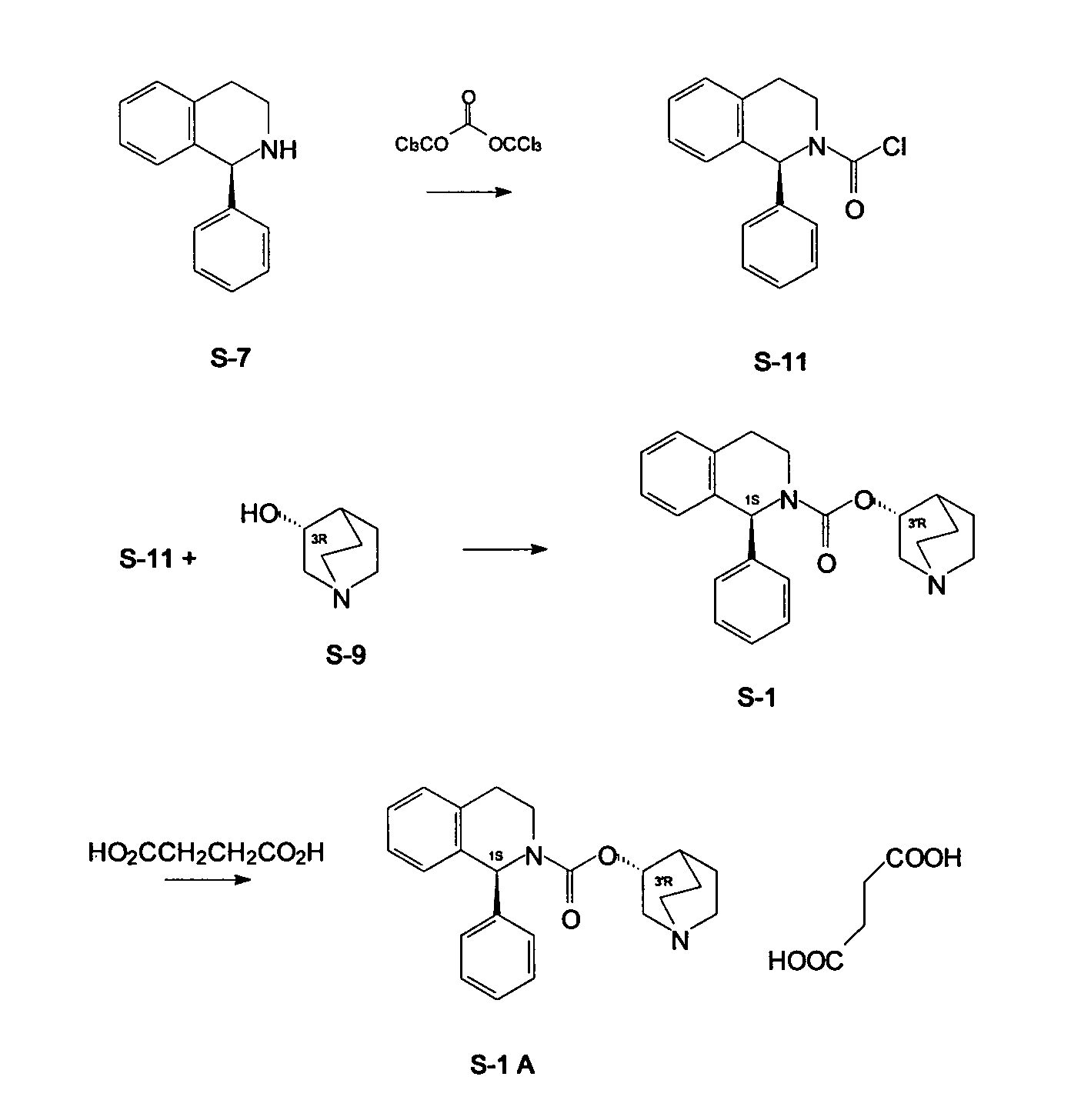Process for Preparation Of Solifenacin and/or the Pharmaceutically Acceptable Salts Thereof of High Pharmaceutical Purity
- Summary
- Abstract
- Description
- Claims
- Application Information
AI Technical Summary
Benefits of technology
Problems solved by technology
Method used
Image
Examples
example 1
[0050]A. (S)-1-Phenyl-1,2,3,4-tetrahydroisoquinolinecarbonyl chloride
[0051]In a three-neck flask the solution of triphosgene (10.87 g, 36.63 mmol) in toluene (60 mL) is prepared at room temperature (23° C.), then the reactor is placed in an ice-water cooling bath. In a separate flask (S)-1-phenyl-1,2,3,4-tetrahydroisoquinoline (20.0 g, 95.55 mmol, purity 99% (HPLC)) and pyridine (3.26 mL, 40.30 mmol) are placed in toluene (80 mL), while heating at 50-70° C. until the whole amount of solid is dissolved. After cooling down to room temperature, the clear toluene solution is transferred into a dropping funnel. The solution is added dropwise within ca. 10 min. to triphosgene in toluene solution. When the addition is complete, the cooling bath is removed and the reactor is submerged in an oil bath. Reaction mixture is heated at 70-80° C., in a mean time thick yellow solid slowly dissolves. Since reaction temperature reaches 50° C., heating and stirring is continued for 45 min., until disa...
example 2
[0053]A. (S)-1-Phenyl-1,2,3,4-tetrahydroisoquinolinecarbonyl chloride
[0054]In a three-neck flask the solution of triphosgene (10.87 g, 36.63 mmol) in toluene (60 mL) is prepared at room temperature (23° C.), then the reactor is placed in an ice-water cooling bath. In a separate flask (S)-1-phenyl-1,2,3,4-tetrahydroisoquinoline (20.0 g, 95.55 mmol, purity 99% (HPLC)) and pyridine (3.26 mL, 40.30 mmol) are placed in toluene (80 mL), while heating at 50-70° C. until the whole amount of solid is dissolved. After cooling down to room temperature, the clear toluene solution is transferred into a dropping funnel. The solution is added dropwise within ca. 10 min. to triphosgene solution in toluene. When the addition is complete, the cooling bath is removed and the reactor is submerged in an oil bath. Reaction mixture is heated at 70-80° C., in a mean time thick yellow solid slowly dissolves. Since reaction temperature reaches 50° C., heating and stirring is continued for 45 min., until disa...
example 3
Solifenacin Succinate
[0056]Crude oily solifenacin (35 g) obtained in Example 1 is dissolved in isopropanol (100 mL) at room temperature (20-24° C.). In a separate flask the solution of succinic acid (11.30 g, 95.55 mmol) in isopropanol (130 mL) is prepared at reflux for 5 min. The hot succinic acid solution is slowly added to the solifenacin solution in isopropanol. The resulting mixture is left to reach room temperature. At ca. 45° C. the mixture turned to be cloudy and white crystalline solid begins to precipitate. The solution is left at room temperature for 2 h 30 min. The crystalline solid is filtered off and washed with cold isopropanol (10° C.) (3×40 mL), then it is dried under reduced pressure (0.1-0.15 mmHg, room temperature, 2 h) to dry mass. After two steps solifenacin succinate is obtained in 38.9 g, (84.8%) yield, of purity (HPLC) 99.39%. The final product (38 g) is recrystallized in isopropanol (150 mL), yielding 34.4 g (90.7%) of solifenacin succinate of purity (HPLC)...
PUM
| Property | Measurement | Unit |
|---|---|---|
| Temperature | aaaaa | aaaaa |
| Fraction | aaaaa | aaaaa |
| Fraction | aaaaa | aaaaa |
Abstract
Description
Claims
Application Information
 Login to View More
Login to View More - R&D
- Intellectual Property
- Life Sciences
- Materials
- Tech Scout
- Unparalleled Data Quality
- Higher Quality Content
- 60% Fewer Hallucinations
Browse by: Latest US Patents, China's latest patents, Technical Efficacy Thesaurus, Application Domain, Technology Topic, Popular Technical Reports.
© 2025 PatSnap. All rights reserved.Legal|Privacy policy|Modern Slavery Act Transparency Statement|Sitemap|About US| Contact US: help@patsnap.com


